
Greenpeace is an independent global campaigning network, founded in Canada in 1971 by Irving Stowe and Dorothy Stowe, immigrant environmental activists from the United States. Greenpeace states its goal is to "ensure the ability of the Earth to nurture life in all its diversity" and focuses its campaigning on worldwide issues such as climate change, deforestation, overfishing, commercial whaling, genetic engineering, and anti-nuclear issues. It uses direct action, advocacy, research, and ecotage to achieve its goals.

PJSC Gazprom is a Russian majority state-owned multinational energy corporation headquartered in the Lakhta Center in Saint Petersburg. As of 2019, with sales over $120 billion, it was, until 2023, ranked as the largest publicly listed natural gas company in the world and the largest company in Russia by revenue. In the 2020 Forbes Global 2000, Gazprom was ranked as the 32nd largest public company in the world. The Gazprom name is a contraction of the Russian words gazovaya promyshlennost. In January 2022, Gazprom displaced Sberbank from the first place in the list of the largest companies in Russia by market capitalization. In 2022, the company's revenue amounted to 8 trillion rubles. In 2023, the company is delisted from international markets, and continues substantial constriction in its operational results.

MSV Fennica is a Finnish multipurpose icebreaker and offshore support vessel. Built in 1993 by Finnyards in Rauma, Finland and operated by Arctia Offshore, she was the first Finnish icebreaker designed to be used as an escort icebreaker in the Baltic Sea during the winter months and in offshore construction projects during the open water season. Fennica has an identical sister ship, Nordica, built in 1994.
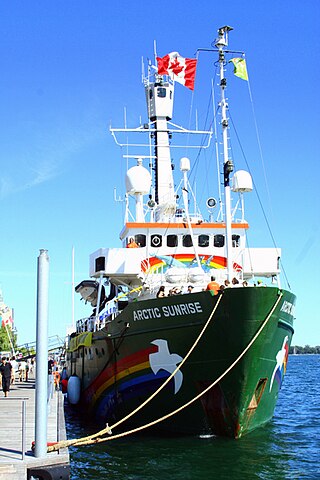
Arctic Sunrise is an ice-strengthened vessel operated by Greenpeace. The vessel was built in Norway in 1975 and has a gross tonnage of 949, a length of 50.5 metres (166 ft) and a maximum speed of 13 knots. She is classified by Det Norske Veritas as a "1A1 icebreaker". The ship is powered by a single MaK marine diesel engine.
Peter Willcox is an American sea captain best known for his activism with the environmental organization Greenpeace. He was on board as captain of the Rainbow Warrior when it was bombed and sunk by the DGSE in New Zealand in 1985.

Lego City is a theme under which Lego building sets are released based on city life, with the models depicting city and emergency services, airport, train, construction, and civilian services. Legoland Town is one of the three original themes that Lego produced upon its launch of the Lego minifigure in 1978 along with Castle and Space. The Town brand was briefly replaced with Lego World City in 2003 and 2004 before it was simply rebranded as Lego City in 2005.
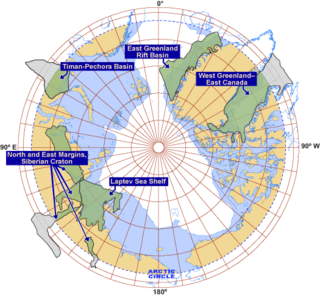
Exploration for petroleum in the Arctic is expensive and challenging both technically and logistically. In the offshore, sea ice can be a major factor. There have been many discoveries of oil and gas in the several Arctic basins that have seen extensive exploration over past decades but distance from existing infrastructure has often deterred development. Development and production operations in the Arctic offshore as a result of exploration have been limited, with the exception of the Barents and Norwegian seas. In Alaska, exploration subsequent to the discovery of the Prudhoe Bay oilfield has focussed on the onshore and shallow coastal waters.

The Pechora Sea is an Arctic sea to the north-west of European Russia, forming the south-eastern portion of the Barents Sea. It is bordered to the west by Kolguyev Island; to the east by Vaygach Island's western coasts and the Yugorsky Peninsula; and to the north by the southern end of Novaya Zemlya.

Sakhalin Energy Investment Company Ltd. is a consortium for developing the Sakhalin-2 oil and gas project with corporate head office in Yuzhno-Sakhalinsk. Roman Dashkov has been the Chief Executive Officer since 2013.
Leila Deen is a British environmental activist, campaigning on the issues of climate change, poverty and water politics. She is program director at SumOfUs in Washington, DC. Previously, she led Greenpeace UK's campaign against fracking and was projects director with Greenpeace USA until 2019. She was previously an activist with the World Development Movement and Plane Stupid. She is most widely known for pouring green custard on the then Business Secretary Lord Mandelson in March 2009 in protest against the extension of Heathrow Airport, for which she was arrested and cautioned.

Philip David Radford is an American activist who served as the executive director of Greenpeace USA. He was the founder and President of Progressive Power Lab, an organization that incubates companies and non-profits that build capacity for progressive organizations, including a donor advisory organization Champion.us, the Progressive Multiplier Fund and Membership Drive. Radford is a co-founder of the Democracy Initiative, was founder and executive director of Power Shift, and is a board member of the Mertz Gilmore Foundation. He has a background in grassroots organizing, corporate social responsibility, climate change, and clean energy. He currently serves as the Chief Strategy officer at the Sierra Club.
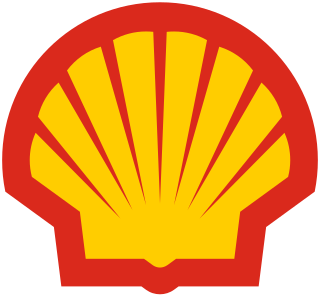
Shell plc is a British multinational oil and gas company headquartered in London, England. Shell is a public limited company with a primary listing on the London Stock Exchange (LSE) and secondary listings on Euronext Amsterdam and the New York Stock Exchange. A core component of Big Oil, Shell is the second largest investor-owned oil and gas company in the world by revenue, and among the world's largest companies out of any industry.
Greenpeace USA is the United States affiliate of Greenpeace International, an environmental nonprofit organization that spawned a social movement inspired by direct actions on the high seas to stop whaling and nuclear testing. Headquartered in Washington D.C., Greenpeace U.S.A. operates with an annual budget of approximately $40 million, employing over 500 people in 2020. The organization relies on donations from members, refuses corporate contributions and refrains from endorsing political candidates, though in 2020 Greenpeace USA issued climate scorecards for presidential candidates and ranked them from best to worst on climate
Prirazlomnoye field is an Arctic offshore oilfield located in the Pechora Sea, south of Novaya Zemlya, Russia, the first commercial offshore oil development in the Russian Arctic sector. The field development is based on the single stationary Prirazlomnaya platform, which is the first Arctic-class ice-resistant oil platform in the world. Commercial drilling was planned to begin in early 2012, however it was delayed at least until the Spring of 2013 due to protester's "safety concerns". Safety concerns have been raised about Prirazlomnoye platform, citing use of decommissioned equipment, however Gazprom's oil spill response plan for Prirazlomnaya was renewed in 2014, and most questions found its answers. The Arctic Prirazlomnoye field produced the 10 millionth barrel of Russian North Arctic Oil in March 2016.

Vladimir Ignatyuk is a Russian icebreaking anchor handling tug supply vessel. She was built by Burrard-Yarrows Corporation in Canada in 1983 as Kalvik as part of an Arctic drilling system developed by BeauDril, the drilling subsidiary of Gulf Canada Resources. After the offshore oil exploration in the Beaufort Sea ended in the early 1990s, she was sold to the Canadian shipping company Fednav in 1997 and renamed Arctic Kalvik. In 2003, she was purchased by Murmansk Shipping Company and transferred to Russia.

The Arctic policy of Russia is the domestic and foreign policy of the Russian Federation with respect to the Russian region of the Arctic. The Russian region of the Arctic is defined in the "Russian Arctic Policy" as all Russian possessions located north of the Arctic Circle. Approximately one-fifth of Russia's landmass is north of the Arctic Circle. Russia is one of five littoral states bordering the Arctic Ocean. As of 2010, out of 4 million inhabitants of the Arctic, roughly 2 million lived in arctic Russia, making it the largest arctic country by population. However, in recent years Russia's Arctic population has been declining at an excessive rate.

Arctic Challenger is a barge which has been converted by Superior Energy Services for use in the Arctic drilling operations of Shell Oil Company. This barge is designed to function as a "novel engineering solution" which they refer to as an Arctic Containment System to respond should a blowout event occur at drilling sites in the Beaufort or Chukchi Seas. According to testimony provided to Senator Mark Begich on 11 October 2012, Coast Guard Rear Admiral Thomas Ostebo said the certification for the Shell spill barge Arctic Challenger to operate in Alaska was given on the 10th of October at the Bellingham, Washington shipyard where it was constructed. Ostebo is commander of the Coast Guard's 17th district, which covers Alaska.
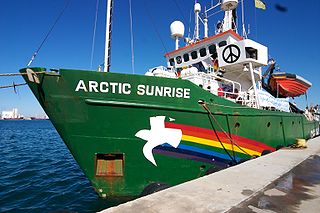
On 18 September 2013, Greenpeace activists attempted to scale the Prirazlomnaya drilling platform, as part of a protest against Arctic oil production.

Protests against Arctic drilling began in Seattle in 2015 in response to the news that the Port of Seattle authority made an agreement with Royal Dutch Shell to berth offshore drillships and semi-submersibles at the Port's Terminal 5 (T5) during the off-season of oil exploration in Alaskan waters of the Arctic. Hundreds of protesters took to Elliott Bay in kayaks, rafts, and other small boats, both as a demonstration and to interrupt docking of Shell's Polar Pioneer semi-submersible drilling vessel at Terminal 5. The waterborne demonstrators were dubbed kayaktivists by social and news media.
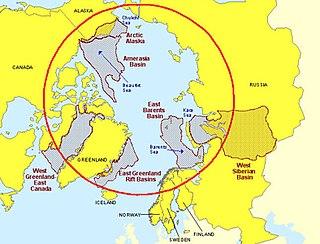
The Arctic resources race is the competition between global entities for newly available natural resources of the Arctic. Under the United Nations Convention of the Law of the Sea, five nations have the legal right to exploit the Arctic's natural resources within their exclusive economic zones: Canada, Russia, Denmark, Norway, and the United States.
















